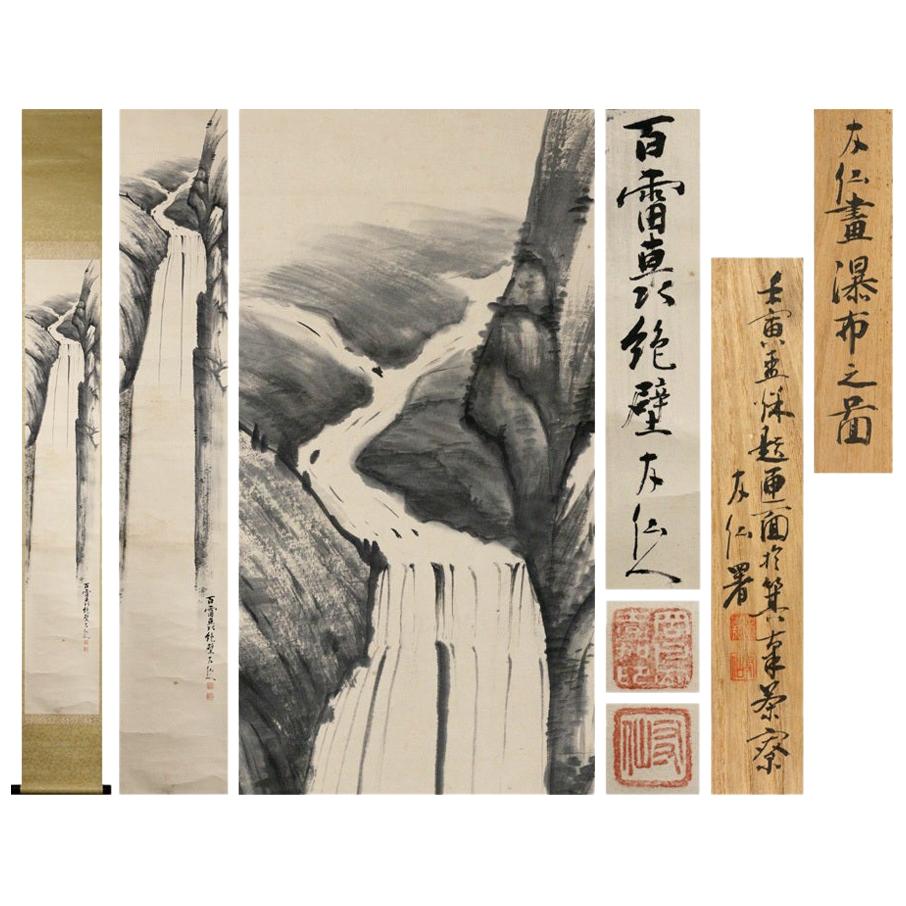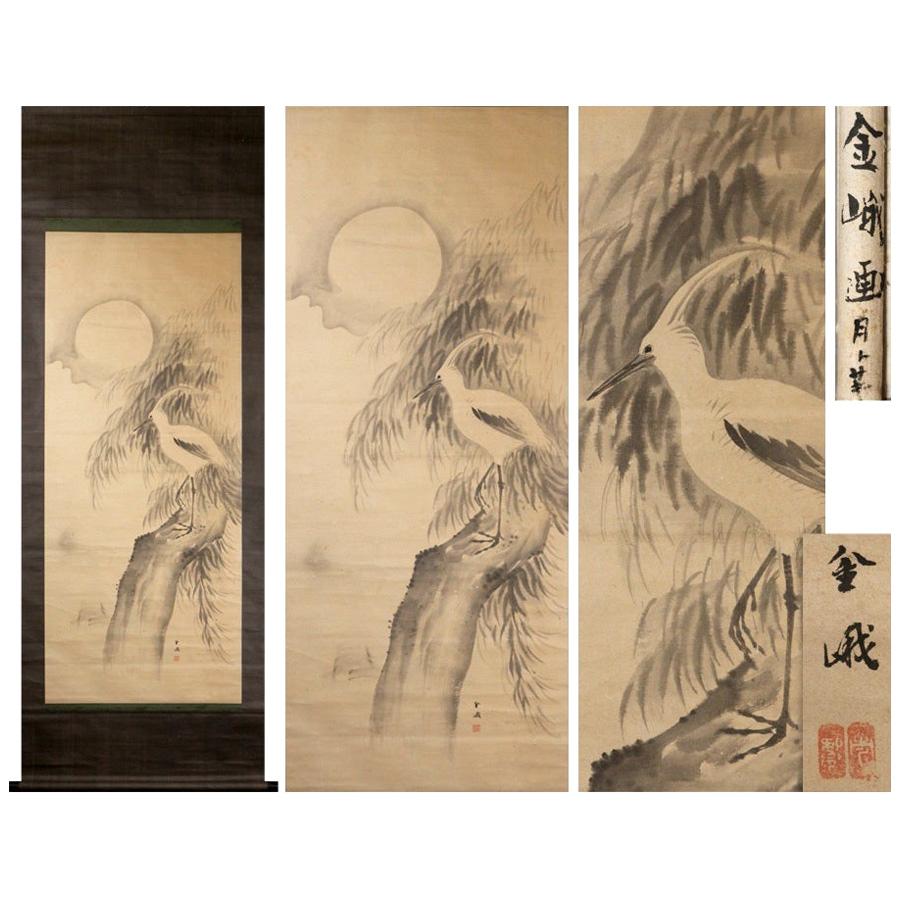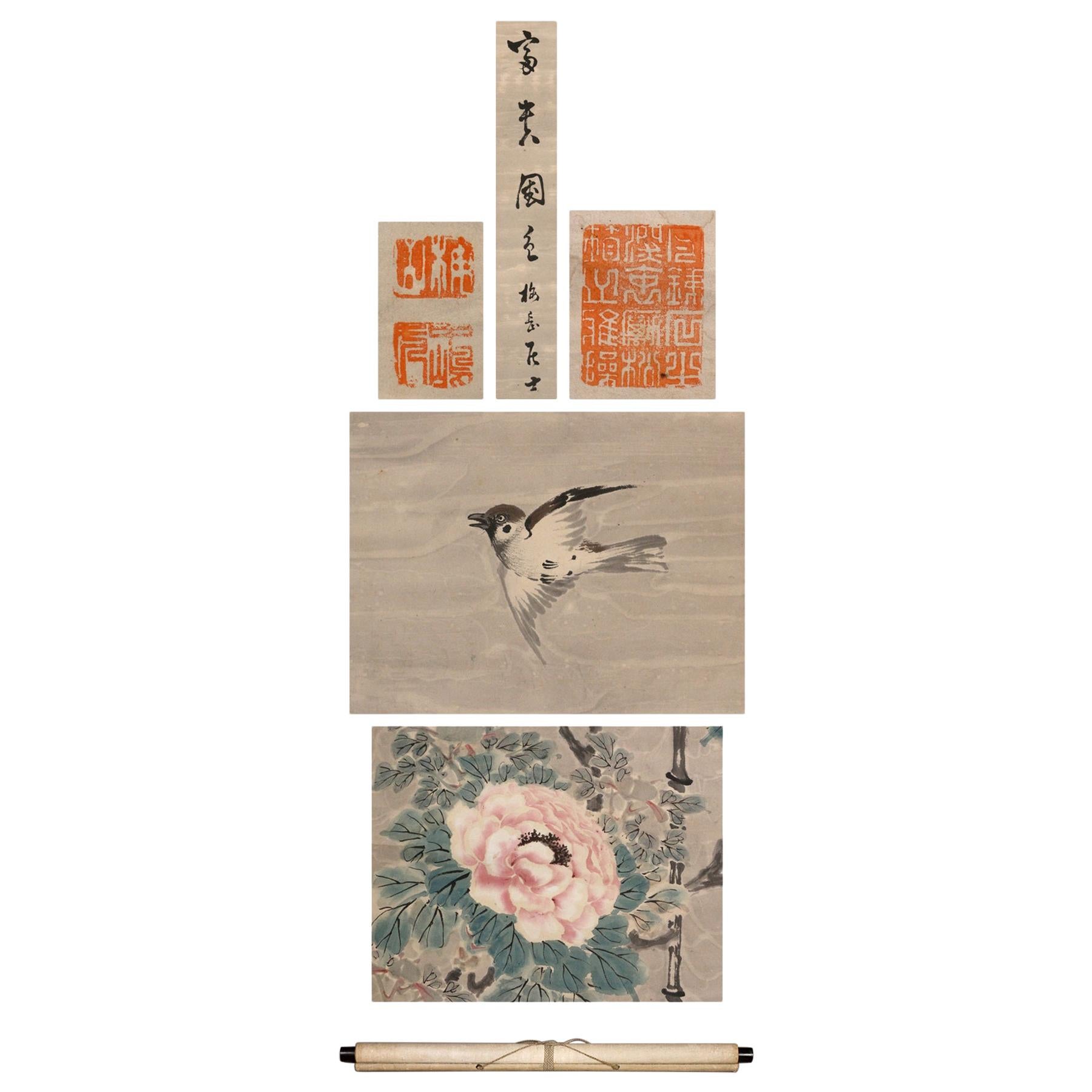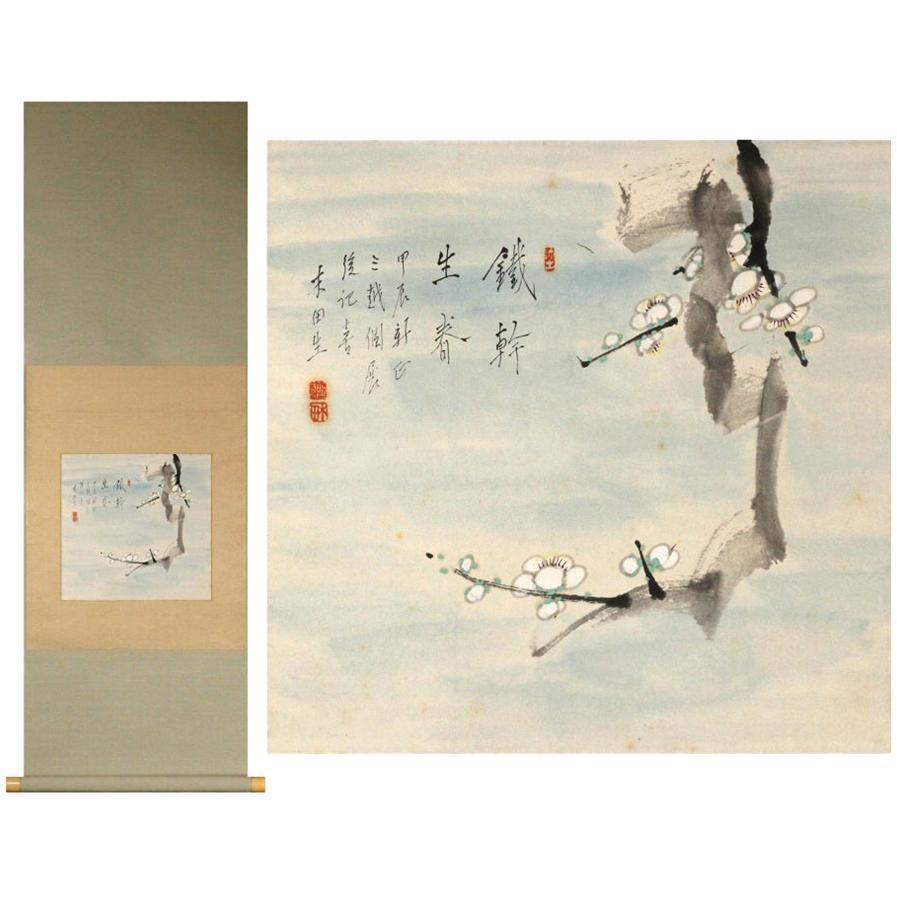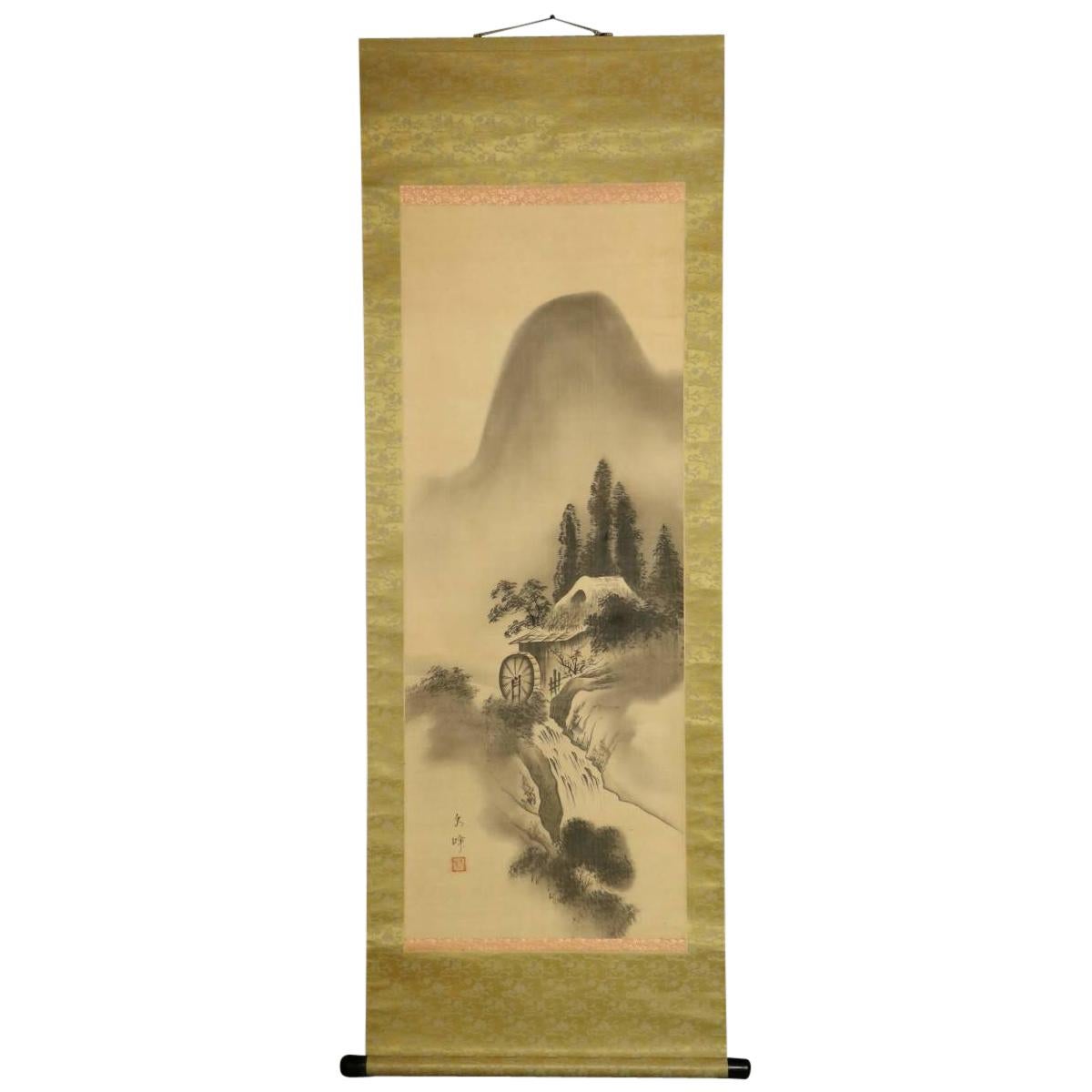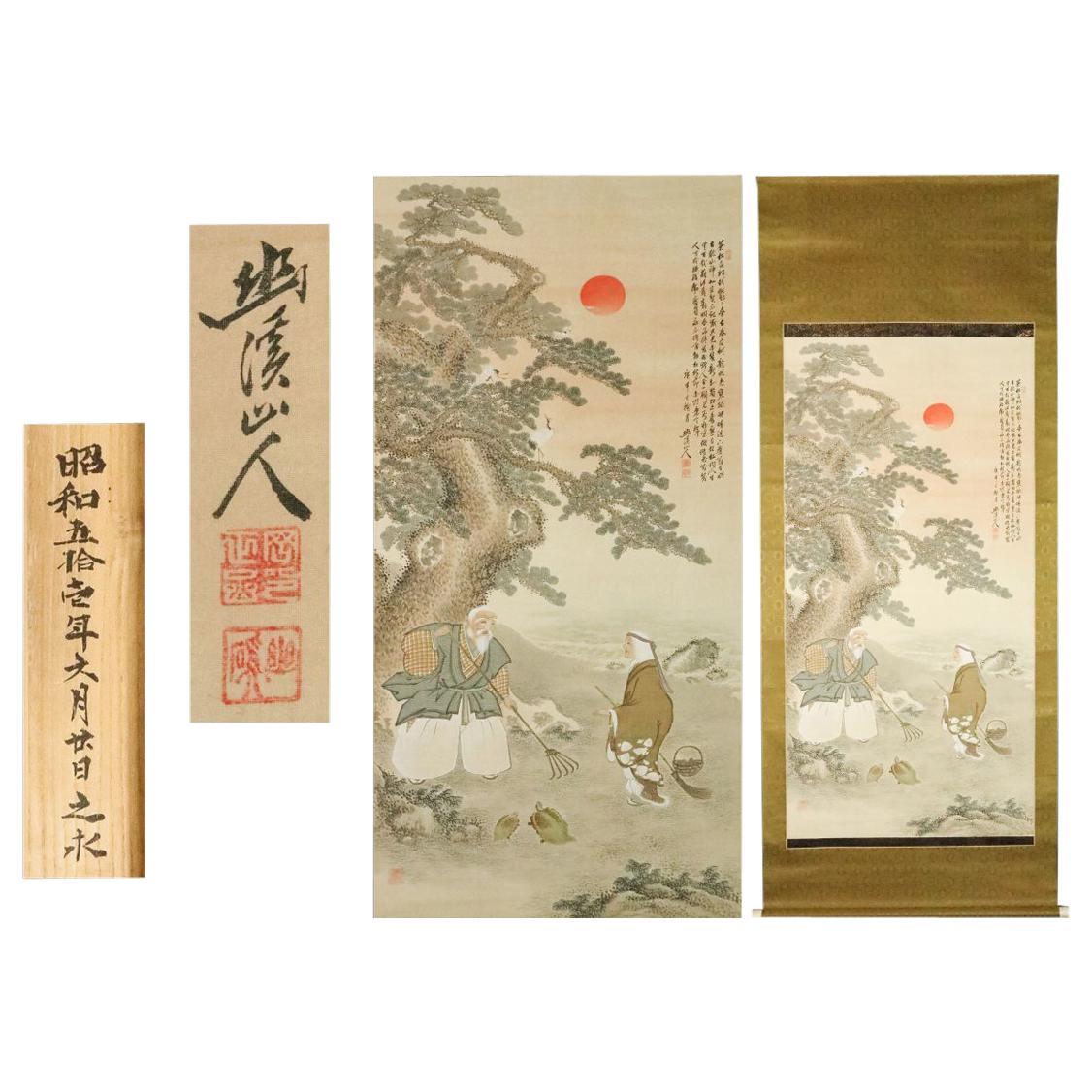Items Similar to Lovely Pair Nihonga Scene Edo Period Scroll Japan Artist Matsumura Keibun Japan
Want more images or videos?
Request additional images or videos from the seller
1 of 5
Lovely Pair Nihonga Scene Edo Period Scroll Japan Artist Matsumura Keibun Japan
About the Item
Early summer rice planting and poultry drawing drawn by Keibun Matsumura As you can see, there are two folding screens.
It
is an interesting work that shows the bird's figure flying to the person who works in rice field and each unique taste. <
Matsumura Keibun (Japanese:?? ??; (1779, Kyoto - 25 May 1843, Kyoto) was a Japanese painter.
Life and work
He was half-brother to Matsumura Goshun, founder of the Shijo school, and received his first art lessons from him. He exhibited his works as early as 1796, under the auspices of Minagawa Kein [ja], a showing which included calligraphy. By 1813, he was listed in a directory of Kyoto's most notable citizens.
In 1818, for the seventh anniversary of his half-brother's death, he staged an exhibition of his works. In 1829, he painted a group of birds on the ceiling inside of the "Naginata-Hoko" (???; roughly, Long Sword Halberd), one of the floats for the Gion Matsuri (festival), which is still in use today.
In 1830, he published an illustrated book; "Go Keibun gafu" (?????, Keibun's Art of Painting), which was a significant contribution to establishing Goshun's style. He also served as Chief Priest at the Myoho-in [ja], a Tendai temple in Kyoto which was usually assigned to an Imperial prince. After his death, he was initially interred at the Daitsu-ji [ja], an Otani-ha temple, but was later moved to the Konpuku-ji, a more prestigious Zen temple.
His style is similar to Goshun's, but somewhat lighter and what, in Western art, would be called manneristic. His best known works are a set of fusumas (sliding doors) in Myoho–ji, a Nichiren temple, which are called Shiki kosaku-zu (?????; roughly, "Cultivation in the Four Seasons").
The items need to be re-attached / reframed to a scroll
There is discoloration etc.
Size of actual paper/approx. 128.0 cm x 53.5 cm.
Incorporation/There are inscriptions/incorporations, etc. as you see.
Box/None.
- Dimensions:Height: 50.4 in (128 cm)Width: 21.07 in (53.5 cm)Depth: 0.04 in (1 mm)
- Style:Edo (Of the Period)
- Materials and Techniques:
- Place of Origin:
- Period:
- Date of Manufacture:19th Century
- Condition:Wear consistent with age and use. ■ State There is discoloration it needs to be reframed and reattached. It is very old and needs some love! ■Size of actual paper/approx. 128.0 cm x 53.5 cm. ■ Incorporation/There are inscriptions/incorporations, etc. as you see. ■ Box/None.
- Seller Location:Amsterdam, NL
- Reference Number:
About the Seller
5.0
Gold Seller
These expertly vetted sellers are highly rated and consistently exceed customer expectations.
Established in 2015
1stDibs seller since 2019
158 sales on 1stDibs
Typical response time: 11 hours
- ShippingRetrieving quote...Ships From: Amsterdam, Netherlands
- Return PolicyA return for this item may be initiated within 14 days of delivery.
More From This SellerView All
- Lovely Nihonga Scene Edo Period Scroll Japan Artist Yusen Okajima JapanLocated in Amsterdam, Noord HollandIt is a work drawn by Yusen Okajima known as a Japanese painter of the Shijo school as you can see. It is a waterfall map that makes you feel momentum from the top to the bottom, a...Category
Antique Early 19th Century Japanese Edo Paintings and Screens
MaterialsSilk
- Lovely Nihonga Scene Meiji/Edo Period Scroll Japan Artist Furuichi KintomeLocated in Amsterdam, Noord HollandIt is a work drawn by Furuichi Kintomi as you can see. In addition to the fantastic depth of willow under the moon, the Egret that shines in the night view is a truly delicious pie...Category
Antique 19th Century Japanese Meiji Paintings and Screens
MaterialsSilk
- Lovely Nihonga Scene Meiji/Edo Period Scroll Japan Artist Flowers and SnowLocated in Amsterdam, Noord HollandAs you can see, this is a work in which a snow fence and a cold peony sparrow figure was drawn by Mt. In addition to the cold snow peony in the snowfall that makes you feel a myster...Category
Antique 19th Century Japanese Showa Paintings and Screens
MaterialsSilk
- Lovely Nihonga Scene Showa Period Scroll Japan Artist Fujimoto KidaLocated in Amsterdam, Noord HollandIt is a work produced by Fujimoto Kida as you can see. It is composed of a calm and cool texture, and combined with the sanction on the top, it is a very tasty work. "Fujimoto K...Category
Mid-20th Century Japanese Showa Paintings and Screens
MaterialsSilk
- Lovely Nihonga Scene Meiji/Taisho Period Scroll Japan Artist PaintingLocated in Amsterdam, Noord HollandLovely Nihonga scene Meiji/Taisho period scroll Japan artist painting. Painting size: (Width x height) mm 525 x 1499.Category
Antique 19th Century Japanese Meiji Paintings and Screens
MaterialsSilk
- Lovely Nihonga Scene Taisho / Showa Period Scroll Japan Artist Landscape FigureLocated in Amsterdam, Noord HollandAxis: Vertical 192 cm, horizontal 38.3 cm Inside: Vertical 130 cm, horizontal 35 cm some errors will occur in the dimensions. Please understand. I don't know the details of the aut...Category
Antique 19th Century Japanese Meiji Paintings and Screens
MaterialsSilk
You May Also Like
- Silk Scroll Painting by Matsumura Keibun, 18th CenturyBy Matsumura KeibunLocated in New York, NYA silk parchment scroll with a Camellia Flower painting, by Japanese artist Matsumura Keibun (1779-1843). The younger half-brother to Matsumura Goshun, founder of the Shijo schoo...Category
Antique 1790s Asian Edo Paintings and Screens
MaterialsSilk, Parchment Paper
- Japanese Silk Scroll by Haruki Nanmei Edo PeriodLocated in Atlanta, GAA Japanese hanging silk scroll by late Edo period painter Haruki Nanmei (1795-1878). The gouache painting was in the tradition of Kano school and depicts an old scholar dressed in lo...Category
Antique 19th Century Japanese Edo Paintings and Screens
MaterialsSilk, Paper
- Japanese Silk Scroll of Daruma Hanabusa Itcho Edo PeriodLocated in Atlanta, GAA Japanese hanging scroll attributed to Edo period painter Hanabusa Itcho (1652-1724). The artwork features a silk roundel nicely mounted in golden brocade background. The painting depicts a robed Daruma seated in meditation with his eyes widely open. The rendition of the famous monk, one of the most beloved subjects in Japanese art, was extremely minimalistic. With just a few effective ink strokes and patches of watercolor, it managed to successfully highlight the essence and spirit of Daruma. The roundel was possibly a center fragment of a larger painting by the artist and was remounted historically. Signed with one of his artist's names. It comes with a wood scroll box with ink inscription of title and artist formal name. For a painting with the same signature, see number 1881,1210,0.1719 in the collection of the British Musuem. Also a horizontal scroll...Category
Antique 18th Century Japanese Edo Paintings and Screens
MaterialsSilk, Paper
- Early Japanese Gohonzon Buddhist Calligraphy Mandala Scroll Edo PeriodLocated in Atlanta, GAA Japanese sumi ink calligraphy Buddhist mandala mounted as a paper hanging scroll known as Kakejiku or sometimes Moji mandala. Termed as gohonzon in Japanese, it is a venerated object within Nichiren Buddhism (Hokkeshu; lotus sect). The originally concept was developed by the 13th century Buddhist priest Nichiren to guide the energy of the devotional chanting to...Category
Antique 1810s Japanese Edo Paintings and Screens
MaterialsPaper
- Antique hanging scroll of Japanese cat/Late Edo-Meiji period/Cat paintingLocated in Sammu-shi, ChibaThis is a picture of a cat drawn by a person named "Toshizumi Nitta" from the end of the Edo period to the beginning of the Meiji period. She is a very simple and cute cat. He is a vassal of the Tokugawa Shogunate, born in Ota City, Gunma Prefecture (southern part of Gunma Prefecture). He was related to the Tokugawa family and lived in a large mansion in the Ota clan in Gunma prefecture. However, the Nitta family's territory was very small, and they were by no means a wealthy vassal. He seems to have lived quite poorly. So he painted cats and sold them to people. The Nitta family continued to draw pictures of this cat for four generations. "Nitta toshizumi" is equivalent to the fourth generation. During the Edo period, sericulture was thriving in the Kanto region. Cats were said to be the gods of silkworms, as they drive away mice, the natural enemies of silkworms. It was the Nitta family who drew such a cat on paper, pasted it in the silkworm chamber, and sold it as a mouse repellent. There were also other monks who painted pictures of cats, but the Nitta family in particular was related to the Tokugawa family, so people believed that paintings of cats had special powers. , a lot of paintings...Category
Antique Late 19th Century Japanese Edo Paintings
MaterialsPaper
- Antique Japanese Ink Hanging Scroll Nakabayashi Chikuto Edo PeriodBy Hidaka TetsuoLocated in Atlanta, GAAn ink painting on paper (Sumi-e) mounted with brocade borders as a hanging scroll. Entitled "Plum Blossom Under a Misty Moon", the artist was Japanese painter Nakabayashi Chikuto (1...Category
Antique 19th Century Japanese Japonisme Paintings and Screens
MaterialsBrocade, Wood, Paper
